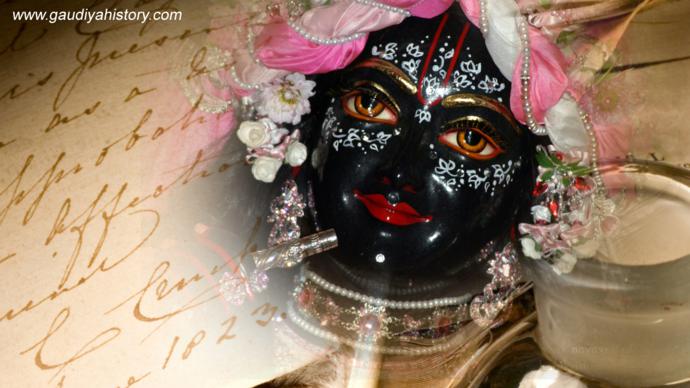Shri Raghupati Upadhyaya was a Brahmin who originated from the region of Mithila. He was born in Tirhut, in the Sitamari subdivision of Darbhanga district in Bihar state. Tirhut or Tiruhita, was also the name for a kingdom which included the four modern districts of Darbhanga, Sitamarhi, Muzaffarpur and Champaran in northwestern Bihar. Paramananda Puri also came from Tirhut.
When Mahaprabhu heard Raghupati Upadhyaya’s verses, he became overwhelmed with feelings of ecstatic love. Shrila Rupa Goswami later included several of these verses in his Padyavali. Krishnadas Kaviraj Goswami has recounted the meeting of Raghupati with the Lord in his Chaitanya Charitamrita. Madhya-lila, 19. This meeting took place when Mahaprabhu was in Prayag and had gone to visit Vallabhacharya in Ariail. [See vol. II, Chapter 3, on Rupa Goswami.]

Let those afraid of material existence worship the Vedas and Upanishads, the smritis and puranas, or the Mahabharata, as they wish. I, on the other hand, shall simply worship Maharaj Nanda, in whose courtyard plays the Supreme Truth. (Padyavali, 126) (In the image: Shri Gopal, His parents Nanda Maharaja and Yashoda Maharani).
At that time Raghupati Upadhyaya arrived there. He was from Tiruhita district, a learned scholar, a Vaishnava and a gentleman. He offered his respects to Shri Chaitanya Mahaprabhu and the Lord blessed him, saying, "May you always remember Krishna." (Chaitanya Charitamrita 2.19.92-3)
When Mahaprabhu asked Raghupati to speak to Him about Krishna, Raghupati recited a verse of his own composition:
shrutim apare smritim itare
bharatam anye bhajantu bhava-bhitah
aham iha nandam vande
yasyalinde param brahma
Let those afraid of material existence worship the Vedas and Upanishads, the smritis and puranas, or the Mahabharata, as they wish. I, on the other hand, shall simply worship Maharaj Nanda, in whose courtyard plays the Supreme Truth. (Padyavali, 126)
Mahaprabhu was ecstatic upon hearing this beautiful verse and asked to hear more. Raghupati acquiesced by reciting another verse he had written:
kam prati kathayitum ishe
samprati ko va pratitim ayatu
go-pati-tanaya-kuïje
gopa-vadhuti-vitam brahma
Whom dare I tell that the Supreme Truth, is lusting after the cowherds’ brides in the bushes by the banks of the River Yamuna? And who will believe me when I say it? (Padyavali, 98)
As the Lord heard more and more of Raghupati’s compositions, he went deeper and deeper into a trance of prema, demonstrating powerful ecstatic symptoms which made a great impression on the scholar, leading him to believe that Mahaprabhu was Krishna Himself.
Mahaprabhu then asked Raghupati which of Krishna’s many forms was the best. The scholar replied: "The Lord’s blackish form is supreme." Mahaprabhu then asked, "Which abode of the Lord is the best?" Raghupati answered, "Mathura is the best city." In response to Mahaprabhu’s question about Krishna’s best age, he answered that it was His adolescence. And then to the question about the best amongst the rasas, Raghupati stated that the primary rasa, or the erotic mood, was supreme. The complete verse is found in the Padyavali (82):
shyamam eva param rupam
puri madhu-puri vara
vayah kaishorakam dhyeyam
adya eva paro rasah
Mahaprabhu embraced Raghupati in His ecstasy and then began to dance. Vallabha Bhatta and all the members of his householders were astounded by Raghupati Upadhyaya’s great fortune.
[Excerpted from “Shri Chaitanya: His Life & Associates” by Shrila Bhakti Ballabh Tirtha Maharaj]

Mahaprabhu then asked Raghupati which of Krishna’s many forms was the best. The scholar replied: "The Lord’s blackish form is supreme." Mahaprabhu then asked, "Which abode of the Lord is the best?" Raghupati answered, "Mathura is the best city." In response to Mahaprabhu’s question about Krishna’s best age, he answered that it was His adolescence. And then to the question about the best amongst the rasas, Raghupati stated that the primary rasa, or the erotic mood, was supreme. (In the wallpaper: Shri Shyamasundara, ISKCON Hungary, New Vraja Dham).

